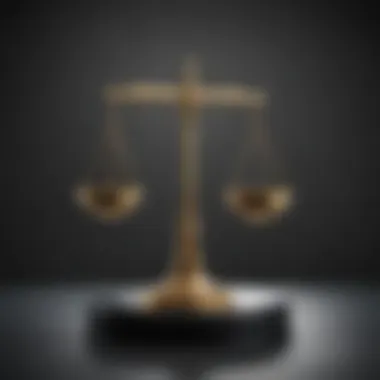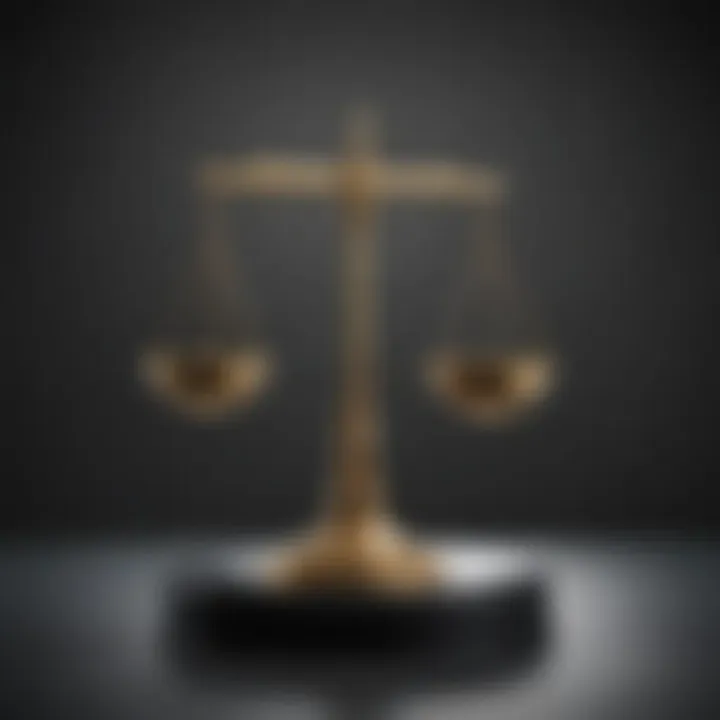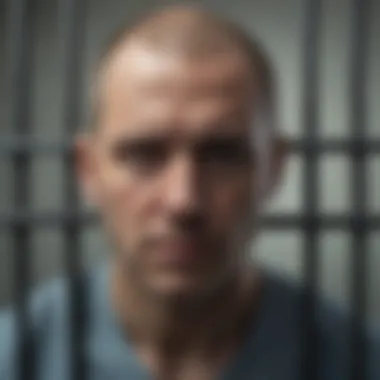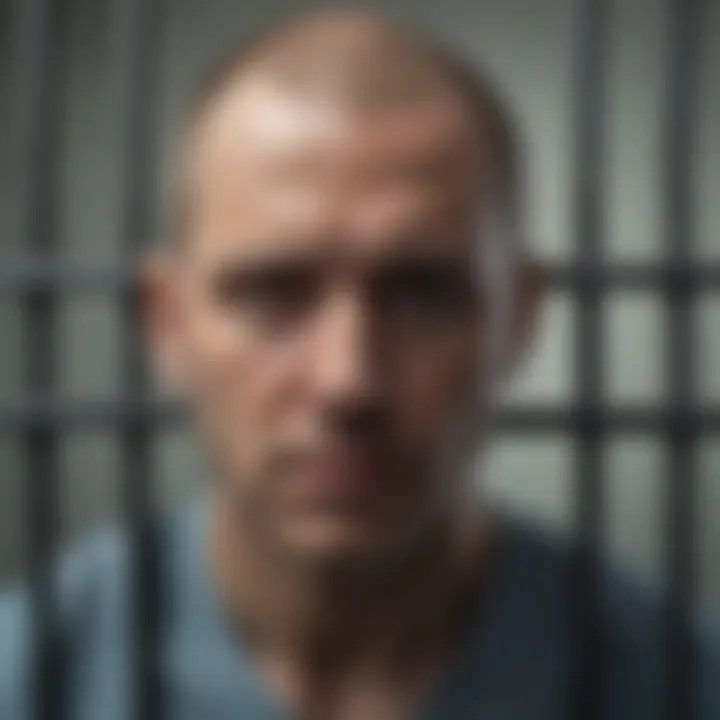The Correctional System: Balancing Punishment and Rehabilitation


Intro
The correctional system plays a pivotal role in how society deals with offenders. Understanding the mechanisms of punishment within this framework requires a closer inspection of the terms and concepts that define the system. From basic definitions to the philosophical ideas that shape punitive practices, we can unravel the complexities of punishment and rehabilitation. This exploration not only highlights essential terminology but also emphasizes the underlying philosophies guiding corrections.
Key Concepts and Terminology
Definition of Key Terms
To effectively engage in a discussion about the correctional system, one must grasp key terms that define the landscape of punishment.
- Punishment: A practice aimed at enforcing a consequence for wrongdoing, it varies in its form and severity.
- Rehabilitation: Aims to reform offenders, enabling them to reintegrate into society while reducing recidivism.
- Deterrence: The prevention of future criminal behavior through the fear of punishment.
- Restorative Justice: A philosophy that focuses on repairing harm through reconciliation between offenders and victims.
These terms lay the groundwork for understanding the more nuanced discussions that follow regarding the implications of each punishment methodology.
Concepts Explored in the Article
In this piece, various methodologies of punishment are examined. For instance, the approach of punitive measures often walks a tightrope between retribution and rehabilitation. The tension between these two aspects poses essential questions: How can the system hold offenders accountable while simultaneously fostering their potential for change? Moreover, societal expectations regarding punishment influence how offenders are treated within the system.
Findings and Discussion
Main Findings
Research illustrates a stark contrast between punitive measures and rehabilitative ones. While punishment aims to penalize, it often neglects the rehabilitation aspect, which is equally crucial. A significant finding reveals that systems primarily focused on punishment tend to experience higher rates of recidivism.
To put it plainly, a punitive environment can foster the very behaviors it seeks to eliminate, creating a cycle that is hard to break.
Another discovery points towards the growing preference for restorative justice programs, which have shown promise in reducing repeat offenses. Engagement with victims and a focus on making amends are elements that often engender positive outcomes.
Potential Areas for Future Research
Moving forward, potential research avenues exist that can improve our understanding of the correctional system. Questions worth exploring include:
- How can restorative justice models be implemented more widely?
- What impact does socioeconomic status have on rehabilitative success?
- In what ways do public perceptions of punishment affect policy decisions?
Each of these inquiries could peel back another layer of complexity, offering valuable insights into how societies can craft a fairer correctional system. By examining the philosophical underpinnings and practical challenges, we can identify opportunities for improvement within a framework that seeks not just to punish but to heal.
Prologue to the Correctional System
The correctional system is a cornerstone of modern society's approach to justice. Understanding its nuances is vital for students, researchers, educators, and professionals alike. This section will shed light on how this system operates, the strategies it employs in punishing offenders, and its overarching significance in maintaining social order.
The correctional system isn't just about confinement; it's about a broader spectrum of consequences that influence behavior, restore order, and ideally, support rehabilitation. The actions taken within this framework have far-reaching effects, both on individuals involved and society at large. Knowing these aspects offers valuable insight into the philosophical and practical dimensions of punishment.
Understanding Punishment in Context
Punishment within the correctional system serves various purposes. Traditionally, it has been seen primarily as a deterrent. The notion is rather straightforward: punish offenders to prevent future crimes. However, this does not encapsulate the complete picture.
Contextualizing punishment involves recognizing the societal values that shape our understanding of consequences. In some cultures, punishment might lean more toward retribution, focusing on exacting a deserved response. In others, there might be a heavier emphasis on rehabilitation, considering the offender's potential for change. Here are a few key considerations:
- Cultural Influences: Different societies approach punishment with unique perspectives, often influenced by historical and cultural contexts.
- Types of Offenses: The nature of offenses, whether violent crimes or non-violent misdemeanors, impacts the approach taken, leading to varied punitive measures.
- Legal Frameworks: The laws governing punishment can shift significantly based on regional legislation, highlighting the fluidity of what punishment entails.
Understanding these aspects is essential for grasping the complexities of how the correctional system operates. It's not a one-size-fits-all solution but rather a tapestry of approaches that reflect the collective values of a society.
Objectives of the Correctional System
The correctional system is designed with several objectives in mind, and these aims can often conflict or align in nuanced ways. Let's delve into these goals:
- Deterrence: One of the primary objectives is to deter potential offenders from committing crimes, creating a ripple effect that ideally benefits society as a whole.
- Rehabilitation: A significant focus is placed on rehabilitating offenders through various programs, aiming to reintegrate them into society successfully.
- Public Safety: Ultimately, ensuring public safety remains at the forefront, which involves not only punishment but also the management of offenders in a way that minimizes risk to the community.
- Restoration: Promoting healing for victims and communities is increasingly recognized as a vital part of modern correctional aims. This includes compensatory measures for victims and engagement in restorative justice practices.
These objectives paint a clearer picture of what the correctional system strives to achieve. By connecting punishment to these intent-based goals, it becomes easier to evaluate the efficacy of various punitive measures and their impact on society.
"A fair and just correctional system provides not just consequences for actions but a pathway for individuals to transform and contribute positively to society."
In summary, the correctional system plays a crucial role in shaping societal norms around behavior and consequence. By understanding the context of punishment and the objectives it aims to fulfill, we can better appreciate the intricate balance required to administer justice.
Philosophical Foundations of Punishment
The domain of punishment possesses deep philosophical roots, which serve as a compass guiding both the implementation and understanding of various correctional practices. The philosophical foundations of punishment not only shape legal frameworks but also frame societal attitudes toward justice and accountability. Understanding these nuances can help delineate why certain punitive measures are favored over others, and can provoke critical discourse about their moral and ethical implications.
Retributive Justice
Retributive justice is a framework that underscores punishment as a form of moral accountability. According to this school of thought, offenders deserve to face consequences proportional to their misdeeds. It operates on the premise that when individuals violate laws, they disrupt the societal order, and thus a response—punishment—is necessary to restore that balance. The driving idea behind retributive justice is often encapsulated in the saying, "an eye for an eye." This principle can instill a sense of satisfaction in victims as well as reinforce societal norms, but it is not without criticisms.


One major criticism is that focusing solely on retribution neglects the broader context of offender circumstances—such as socioeconomic factors driving criminal behavior. This view can lead to harsher penalties without addressing underlying issues, which may contribute to recidivism. Additionally, such rigidity might promote a cycle of vengeance rather than an emphasis on healing, thus challenging the effectiveness of a purely retributive approach.
Utilitarian Perspectives
In contrast, utilitarian perspectives advocate for punishment measures that maximize overall happiness and well-being. This philosophy posits that punishments should be designed to deter future crime and rehabilitate offenders. The rationale here is simple: if punishment leads to a decrease in criminal behavior, then society benefits as a whole. This view encourages flexible and adaptive approaches to justice, underscoring the importance of monitoring and evaluating punitive measures to see what's effective.
Utilitarianism reconciles the need for accountability with the desire for positive societal outcomes. It opens the door to a variety of alternatives like community service or restorative justice programs, which can lower the likelihood of re-offense by addressing the root causes of criminal actions. This approach may challenge the traditional notions of justice but advocates for a more progressive vision of effective punishment.
Restorative Justice
Restorative justice takes a markedly different approach by focusing on healing rather than punishment. It emphasizes repairing the harm caused by criminal behavior through inclusive processes that engage victims, offenders, and the community. The essence of restorative justice is captured beautifully in the principle that “justice should repair, not just punish.”
Through methods like mediation and dialogue, restorative justice aims to foster understanding and empathy. Offenders are encouraged to take responsibility for their actions and can participate in restitution efforts that address the losses endured by victims. This way, the emphasis shifts from the crime to relationships and social cohesion, providing a more comprehensive means for reconciliation.
However, critics often argue that restorative justice misconceptions can arise when offenders are left unpunished in traditional senses. There's concern that some may use this as an excuse to escape heavier consequences for their actions. This perception leads to ongoing discussions about how to appropriately balance accountability with healing efficacy.
"Justice should repair, not just punish.”
In sum, the philosophical underpinnings of punishment are not only about individual schools of thought; they culminate in broader societal implications regarding how we view justice. Whether one favors retribution, utilitarianism, or restorative justice, each perspective brings unique insights that shape our correctional systems, challenging us to find a balance between punishing offenders and considering their potential for rehabilitation.
Types of Punishment and Their Implementation
Understanding the types of punishments within the correctional system is crucial for comprehending how society deals with those who violate laws. Each method carries with it a unique set of consequences and implications, affecting not only the offenders but also their families and the community at large. By examining the different forms of punishment, one can get a clearer picture of the balance between holding individuals accountable and the overarching goal of rehabilitation.
Incarceration
Incarceration represents the most traditional form of punishment, where offenders are confined within correctional facilities. This method serves various purposes, including deterring potential criminals, incapacitating offenders from committing further crimes, and offering a degree of retribution for their actions.
However, the practice of incarceration has its criticisms. Many argue that it often leads to overcrowded prisons, which can become breeding grounds for violence and further criminal behavior rather than rehabilitation. Research has shown that long-term inmates frequently struggle with issues of identity and reintegration upon release, which raises questions about the effectiveness of simply locking individuals away. Studies reveal that without proper educational and vocational programs, many incarcerated individuals leave prison with the same issues, if not worse, than when they entered.
Probation and Parole
Probation and parole offer alternative measures to incarceration, focusing on integrating offenders back into society under supervised conditions. These options allow individuals to continue fulfilling societal roles, such as maintaining employment and family connections, while still being held accountable for their actions.
Probation is usually granted instead of a prison sentence, allowing offenders a chance to prove they've learned from their mistakes. On the other hand, parole involves early release from prison, provided the individual adheres to specific conditions and demonstrates good behavior.
While these methods can be effective, they are not without challenges. Monitoring individuals on probation or parole requires substantial resources, which many correctional systems lack. Additionally, the stigma of having a criminal record can hinder employment opportunities, increasing the likelihood of recidivism.
Fines and Restitution
Fines and restitution serve as financial penalties aimed at holding offenders accountable while allowing for a form of restitution to the victims. Fines are monetary penalties imposed as part of a judgment, often for lesser offenses. They usually aim to deter similar behaviors but can disproportionately affect lower-income individuals who may struggle to pay them outright.
Restitution, on the other hand, requires the offender to pay back the victim for losses incurred due to their crime. This approach symbolizes a step toward taking responsibility for one's actions and can provide some form of closure for victims. However, collecting these payments can often be a cumbersome process, leading to further frustration for victims who feel their losses are not adequately addressed.
In essence, the implementation of various types of punishment reflects a society's values, priorities, and understanding of justice. Each method carries unique advantages and obstacles, shaping the landscape of the correctional system in profound ways. As we reflect on these measures, it becomes increasingly important to recognize how they affect not just offenders, but everyone involved.
The Impact of Punishment on Offenders
The implications of punishment extend far beyond mere incarceration or financial penalties. They profoundly shape the lives of offenders, influencing their mental health, social standing, and ability to reintegrate into society post-punishment. Understanding this impact is crucial, not only for the individuals involved but for the broader community that must reckon with the consequences of punitive measures. The correctional system, in its pursuit of accountability, often intertwines with rehabilitation, searching for a balance that favors both justice and societal well-being.
Psychological Consequences
Punishment inevitably leaves an imprint on the psyche of offenders. Many individuals experience various degrees of psychological distress while serving their time. Stress, anxiety, and depression can become unwelcome companions. It’s like carrying the weight of a thousand bricks, making the road to reconstruction all the more arduous. The punitive environment, with its inherent instability, can exacerbate these issues.
Some research indicates that the isolation experienced during incarceration can lead to deeper mental health issues, including post-traumatic stress disorder. Imagine emerging from a dark tunnel of confinement only to find the world dauntingly different. An analysis of post-release interviews reveals that many offenders struggle with feelings of hopelessness. This psychological toll can hinder their capacity to rehabilitate and reintegrate effectively.
Moreover, the potential for recidivism often rises when an offender hasn’t adequately addressed these mental health issues. A cycle emerges where failing to treat psychological damage leads to further criminal behaviors. Without adequate support systems in place, offenders often feel trapped in a web of depression and anxiety, unable to break free.
"The mark of a successful justice system is not how it punishes but how it empowers individuals for a second chance."
Social Stigmas and Reintegration Challenges
Once individuals complete their sentences, they often face an uphill battle when it comes to reintegration. Society’s perception of former offenders can act like a looming shadow, hindering job prospects and relationships. The stigma surrounding criminal records runs deep, often eclipsing the person behind the label. In many neighborhoods, simply being labeled as an ex-offender can lead to social ostracism.
Finding employment becomes particularly fraught. Many employers, perhaps out of caution or fear, may choose to overlook qualified candidates due to their past. This can create a spiraling effect, further isolating them and pushing them into environments where criminal behavior may seem like the only viable option to make ends meet. It’s akin to a never-ending cycle where the punishment lingers long after the official sentence has ended.
Furthermore, social support networks significantly influence reintegration success. An absence of strong familial or community ties can lead to increased feelings of abandonment, making it all too easy to slip back into old habits. Support organizations are invaluable here, but such resources often lack the necessary funding or awareness, meaning many offenders slip through the cracks.
Thus, the consequences of punishment ripple outward, affecting not just the individual, but the community as a whole. The challenges of stigma and reintegration highlight the urgent need to rethink and innovate within the correctional system, aiming for a holistic approach that fosters healing along with accountability.
The Role of Rehabilitation within Punishment
The concept of rehabilitation has steadily gained traction within the narrative of punishment in the correctional system. Its importance lies not merely in the notion of repaying one’s debt to society, but in addressing the root causes of criminal behavior. Rehabilitation represents a shift from seeing offenders as mere wrongdoers to understanding them as individuals grappling with complex personal circumstances. By focusing on rehabilitation, the system aims to reduce recidivism, enabling offenders to re-enter society equipped with the tools necessary for success rather than just enforcing punishment.


Rehabilitation offers several key benefits:
- Reduction in Recidivism: Effective rehabilitative programs can significantly lower the chances of re-offending. Studies have shown that when individuals receive proper support, they are less likely to revert to criminal lifestyles.
- Economic Benefits: Investing in rehabilitation can lead to long-term cost savings by reducing the need for incarceration. It’s cheaper for governments to support successful reintegration than to keep individuals locked up.
- Social Reintegration: Helping offenders build a pathway back into society fosters a sense of normalcy and community, which is crucial for personal growth and development. It reduces the social stigma attached to ex-offenders, fostering a culture of acceptance.
Despite these benefits, challenges persist in implementing effective rehabilitation programs. The system often encounters funding limitations and, at times, resistance from stakeholders who may view punishment as the primary objective.
While rehabilitation may not entirely substitute punitive measures, it offers a compelling alternative — a chance to strike a balance between ensuring accountability and providing individuals a genuine opportunity for change.
Rehabilitative Programs in Prisons
Prison rehabilitative programs serve as the cornerstone of efforts to help inmates rejoin society as constructive members. These programs encompass a diverse range of methods, including educational initiatives, vocational training, and therapeutic interventions. The goal of each is to foster skills that may have been overlooked or unaddressed prior to incarceration.
- Educational Initiatives: Programs that focus on basic education, literacy, and even higher learning pave the way for inmates to improve their knowledge base. Numerous prisons have established partnerships with educational institutions to facilitate this, allowing inmates to earn diplomas or degrees.
- Vocational Training: Both technical skills and job readiness training are critical for enhancing employability. Skills ranging from carpentry to computer programming position inmates to secure jobs post-release, reducing the likelihood of returning to crime.
- Therapeutic Interventions: These can include counseling and group therapy, aimed at addressing psychological issues and promoting emotional healing. Engaging with mental health professionals helps many inmates confront personal challenges that may have contributed to their criminal behaviors.
Implementing such programs brings a myriad of challenges. Limited resources, staff shortages, and inadequate training can impede the effectiveness of rehabilitative initiatives. Moreover, skepticism around their efficacy can dissuade institutions from fully committing to these paths.
Addressing Substance Abuse and Mental Health Issues
Substance abuse and mental health issues are often intertwined with criminal behavior. Ignoring these facets can undermine the correctional system's objectives. A holistic approach recognizing and addressing these challenges is crucial for successful rehabilitation.
Substance Abuse Programs: Many offenders grapple with addiction problems. Correctional facilities now implement specialized treatment programs aimed at breaking the cycle of addiction while incarcerated. These often involve:
- Detoxification: Providing safe and medically supervised withdrawal to aid recovery.
- Counseling and Support Groups: Sessions that focus on coping strategies and peer support are vital.
Mental Health Treatment: A significant portion of offenders struggles with mental health disorders. Addressing these needs is critical not only for rehabilitation but also for overall public safety. Effective strategies can include:
- Access to Therapists and Psychiatric Care: Regular access to trained professionals ensures that inmates receive appropriate care during their confinement.
- Cognitive Behavioral Therapy: This form of therapy has shown promise in helping individuals achieve better emotional regulation and decision-making skills.
"Addressing both substance abuse and mental health issues can significantly reduce recidivism rates and help offenders build healthier lives after incarceration."
In summary, tackling these problems is not an option but a necessity if the goal is to ensure a safer community while enabling the recovery and reintegration of offenders. Rehabilitation thus stands as a pivotal element within punishment, transforming lives instead of merely serving time.
Public Perception of the Correctional System
Public perception of the correctional system is pivotal in understanding the broader context of how societies engage with crime and punishment. It reflects not just the attitudes of individuals towards offenders but also shapes the policies that govern punitive practices. When society views the correctional system strictly as a means of punishment, it often sidelines the need for reform or rehabilitation. Conversely, a perception that embraces the idea of rehabilitation can lead to more humane treatment of offenders and a focus on reintegration.
The importance of public perception cannot be overstated, as it influences everything from legislative initiatives to funding for programs aimed at helping inmates reintegrate into society. A community that supports rehabilitation, for instance, tends to advocate for educational and vocational programs in prisons, enabling offenders to acquire skills that can help them lead productive lives post-release.
Influence of Media on Punishment Preferences
Media serves as a double-edged sword in shaping public opinion on the correctional system. Television shows, news articles, and films often dramatize crime and punishment, creating narratives that can skew public perception. Sensationalized coverage of certain crimes might stir fear, leading people to favor harsher punishments. Meanwhile, stories focusing on rehabilitation success stories can foster a more supportive attitude toward offenders.
- Sensationalism: Often leads to a belief that crime is rampant and that severe punishments are the only solution.
- Positive Representation: Features like documentaries or human-interest stories can illustrate the potential for change in individuals who have experienced incarceration.
Ultimately, the media not only reflects but also shapes societal attitudes. By continuing to showcase diverse narratives, it has the potential to create a more nuanced understanding of the correctional system and what it means for rehabilitation versus punishment.
Shifts in Public Opinion Over Time
Public opinion is not static; it evolves based on cultural, social, and political climates. Over the last few decades, there’s been a noticeable shift in attitudes towards the correctional system. In certain periods, policies have swung towards punitive measures, reflecting a tough-on-crime mentality. However, as more research emerges regarding the effectiveness of rehabilitation over long-term incarceration, many people are beginning to see the merits of a more balanced approach.
Some notable shifts include:
- Increased Awareness: Education on mental health and addiction is making people more empathetic toward offenders.
- Reform Movements: Advocacy groups pushing for changes in sentencing laws and prison conditions have gained traction, impacting public discourse.
- Alternative Sentencing: There’s a growing acceptance of alternatives to incarceration, like community service or diversion programs.
These changes signal a more reflective dialogue surrounding the correctional system. While fear and punitive responses remain prevalent, ongoing discussions about effective rehabilitation and social justice could reshape how society punishes offenders.
"The perception of crime and punishment is a reflection of societal values; changing hearts and minds can lead to lasting reform."
As we continue to examine the relationship between the public’s view and the correctional system, it's clear that informed discourse can lead to more effective and humane approaches in dealing with crime.
Challenges Faced by the Correctional System
The correctional system is not just a mechanism for punishment; it also plays a critical role in shaping societal attitudes and behaviors. However, this system is fraught with challenges that can hinder its effectiveness. Addressing these issues is paramount as they have profound implications for both offenders and society at large. In this section, we will delve into the pressing challenges of overcrowding and resource limitations, exploring how each impacts the efficacy of the correctional system.
Overcrowding and Its Consequences
Overcrowding within correctional facilities has reached alarming levels in many regions. The phenomenon occurs when inmate numbers exceed building capacity, leading to a ripple effect of complications.
- Living Conditions: Close quarters can breed tension among inmates, fostering a hostile environment that jeopardizes rehabilitation efforts.
- Increased Violence: With limited space, inmate-on-inmate violence tends to rise significantly, creating a volatile atmosphere.
- Staff Burnout: Correctional officers face heightened stress and fatigue in overcrowded facilities, impacting their ability to effectively manage inmates and maintain order.
The consequences are not confined to within the walls of the prison; they extend into the community.


"Overcrowding doesn’t just affect the prison; it reverberates through to the broader society, impacting everything from crime rates to public health."
As prisons become incubators of violence and unrest, the possibility of rehabilitating offenders diminishes. This can create a cycle where released individuals have not been sufficiently prepared to reintegrate into society, counteracting the very goals of the system.
Resource Limitations and Budget Cuts
Another pressing challenge facing correctional systems is resource limitations, exacerbated by budget cuts. Many institutions struggle with inadequate funding, which can severely affect their operations.
- Staffing Issues: Shortages in staff can lead to overworked employees, increasing the possibility of mistakes or oversight in inmate management.
- Lack of Programs: Rehabilitation programs, which should be integral to the correctional process, often receive inadequate resources. This leaves offenders with limited access to educational and therapeutic programs aimed at facilitating reintegration into society.
- Healthcare: Many prisons struggle to provide basic medical care to inmates, creating a public health issue within the facilities, while impacting the overall wellness of a population that may already carry various health burdens.
In essence, resource limitations can severely undermine the core mission of correctional facilities. In the long term, failing to address these challenges only contributes to a system where recidivism rates remain high, and public safety continues to be at risk.
Legal Considerations in Punitive Measures
The legal landscape surrounding punitive measures is vital in shaping how the correctional system operates. The interplay between laws and the rights of offenders ensures that punishment does not occur in a vacuum, but rather within a framework that respects constitutional principles. This section will delve into two significant aspects – offenders' constitutional rights and landmark cases that have fundamentally shifted punishment policy.
Constitutional Rights of Offenders
In any democratic society, the protection of individual rights forms the bedrock of justice. Offenders, despite their actions, maintain certain constitutional rights under the law. These rights include, but are not limited to, the right to due process, the right to humane treatment, and the right to legal representation.
- Due Process: This is paramount. Individuals cannot be deprived of their liberty without fair procedures. This means that every offender deserves a trial before an impartial tribunal, ensuring that evidence is examined fairly.
- Humane Treatment: The Eighth Amendment of the U.S. Constitution prohibits cruel and unusual punishments. This has led to discussions around conditions within correctional facilities and the treatment of inmates, which, in some cases, are shown to be profoundly inadequate.
- Legal Representation: Offenders have the right to an attorney when facing serious criminal charges. This ensures that they can adequately present their case and defend their rights.
These rights, however, can sometimes clash with the system's goal of imposing punishment. For example, overcrowded prison conditions have been challenged as violating the Eighth Amendment. Therefore, understanding these legal frameworks not only highlights the rights of individuals but also reinforces the idea that punishment should not undermine basic human dignity.
Landmark Cases Shaping Punishment Policy
Key judicial decisions have had a profound impact on the correctional system, carving pathways for reform and upholding offenders' rights. A few notable cases include:
- Brown v. Plata (2011): This case addressed severe overcrowding in California prisons. The Supreme Court ruled that such conditions violated the Eighth Amendment, forcing the state to reduce its prison population significantly.
- Roper v. Simmons (2005): Here, the Court ruled that executing individuals who were under 18 at the time of their crime was unconstitutional. This case highlighted the evolving standards of decency and the need for the justice system to consider the age and maturity of offenders.
- Estelle v. Gamble (1976): This decision established that prisoners have a right to adequate medical care. This case underscored the constitutional mandate for humane treatment, further pushing against the prevailing attitudes that often regard offenders solely as punishment subjects rather than individuals with rights.
"The law is reason, free from passion." — Aristotle
Each of these landmark cases not only shaped policy but also influenced public perception regarding justice and humane treatment in the correctional system. Understanding these rulings provides insights into how legal considerations continue to drive conversations about punishment and reforms in the system.
Future Directions in the Correctional System
The notion of looking forward in the correctional system has become increasingly pertinent as society grapples with the effectiveness of current punitive measures. Ignoring the scars of yesterday, the system must evolve to meet the complexities of modern crime and societal expectations. Future directions in this area focus on tailored rehabilitation strategies and the integration of technology, both of which carry significant implications for the efficacy of punishment. These improvements are crucial, urging stakeholders to think critically about how best to serve public safety while fostering successful reentry for offenders.
Innovative Approaches to Rehabilitation
When considering rehabilitation, it's evident that a one-size-fits-all model falls flat. For instance, a recent program targeting female offenders has embraced trauma-informed care, acknowledging their unique experiences and needs. This program underscored the importance of mental health support alongside traditional vocational training. This innovative strategy does not merely aim for low recidivism rates, but seeks to empower individuals, providing them with tools needed to re-acclimate to society post-release.
Furthermore, incorporating peer mentorship can be a game changer. A structure where former offenders guide current inmates allows for real-life insights and relativity that counselors may not provide. Transitioning from a punitive mindset to one that emphasizes personal growth and community reintegration is fundamental.
The system must also prioritize personalized rehabilitation plans. Utilizing assessments that consider individual histories, psychological profiles, and personal aspirations could tailor the rehabilitation experience. This personalized approach could lead to more effective outcomes, lowering the chance of individuals falling back into old habits.
Technology’s Role in Modern Punishment
The impact of technology on the correctional system is hard to overstate. The integration of digital tools ranges from basic management software to more complex solutions like virtual reality for rehabilitation. Imagine inmates engaging in simulated environments that replicate stressors they might face upon release. This immersive experience could significantly prepare them for real-world challenges.
Another significant aspect is the rise of electronic monitoring systems. These tools not only replace traditional incarceration methods but also allow offenders to reintegrate into society while still under supervision. Such systems can provide real-time data on behavior, ensuring a safety net for both the individual and the community.
Of course, there are considerations to keep in mind regarding privacy and ethical implications, but the potential benefits are vast. Data analytics could evolve how parole decisions are made, moving away from outdated practices. By analyzing patterns and predicting behavior, a more nuanced approach to risk assessment can be developed.
"Technology in corrections is not about letting offenders off easy; it’s about aligning accountability with opportunity for change." - Anonymous
As we explore these future directions, it’s clear that the correctional system stands at a crossroads. The choices made today will resonate through the corridors of justice for years to come. It’s a critical juncture that requires thoughtful leadership, innovative thinking, and a commitment to genuine improvement. The journey ahead is not without challenges, but the potential for positive change holds remarkable promise.
Ending: Analyzing the Balance between Punishment and Rehabilitation
In the realm of correctional systems, the ongoing debate surrounding punishment and rehabilitation is paramount. This balancing act isn't merely a theoretical exercise; it holds real-world implications for offenders, victims, and society at large. The crux of the matter lies in how we perceive punishment - is it merely a way to satisfy societal anger, or can it also serve as a pathway to transformation for those who offend?
The Importance of Reform in the Correctional System
Reform in the correctional system is essential, as it directly touches the effectiveness of punishment measures. If we focus solely on punishment, we risk creating a cycle of reoffending. By integrating reformative practices, we set the stage for rehabilitation, which can lead to significant reductions in recidivism.
The benefits of reform include:
- Reducing Recidivism: Programs that focus on rehabilitation rather than mere punishment address root issues related to criminal behavior. Such approaches can significantly decrease the likelihood of repeat offenses.
- Societal Benefits: When offenders are effectively rehabilitated, they can reintegrate into society as productive citizens, contributing positively rather than being liabilities.
- Cost-Effectiveness: Investing in rehabilitation programs can ultimately save taxpayer money, as it reduces the need for prolonged incarceration which can be astronomically expensive.
Moreover, a reformed correctional system must take various considerations into account:
- Individual Needs: Each offender comes with a set of unique circumstances that contributed to their behavior. Tailoring rehabilitation to meet these needs makes for more effective programs.
- Community Involvement: Bringing communities into the fold with support programs can help bridge the gap for reintegration, creating a support network for those coming out of incarceration.
- Evidenced-Based Practices: Utilizing data-driven approaches to reform can ensure that the methods employed are not only effective but also align with current best practices in psychology and sociology.
"Punishment without reform is like locking a door without a key; it prevents entry but doesn't change the nature of what lies behind it."
Ultimately, the dialogue between punishment and rehabilitation should focus on achieving a sustainable balance. It recognizes the need to hold individuals accountable for their actions while fostering an environment where change is possible. This dual approach can pave the way for justice that not only seeks retribution but also champions restoration and healing.
In summation, as we examine the role of the correctional system, the necessity of reform becomes crystal clear. It is not just about what was done, but about paving the way forward for a more hopeful future for offenders, victims, and society as a whole.







